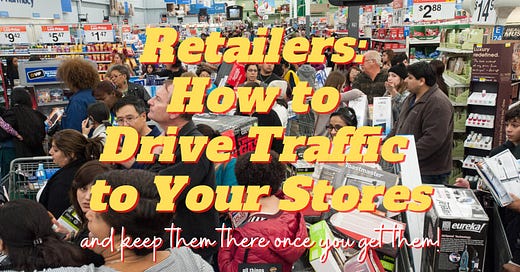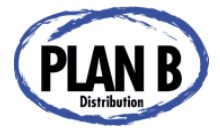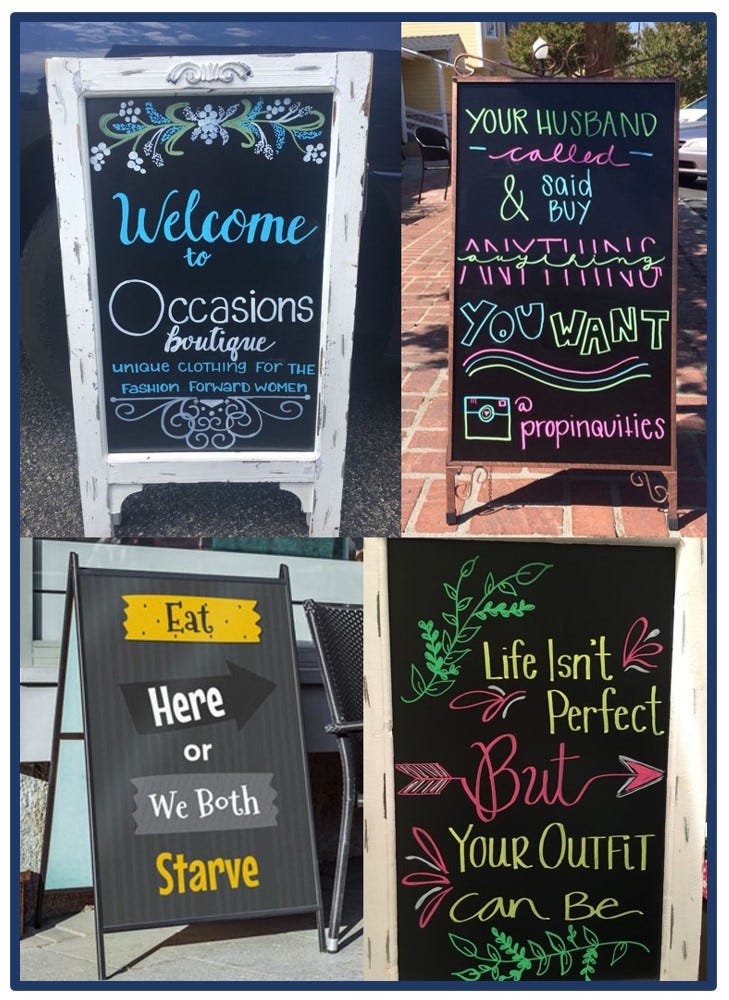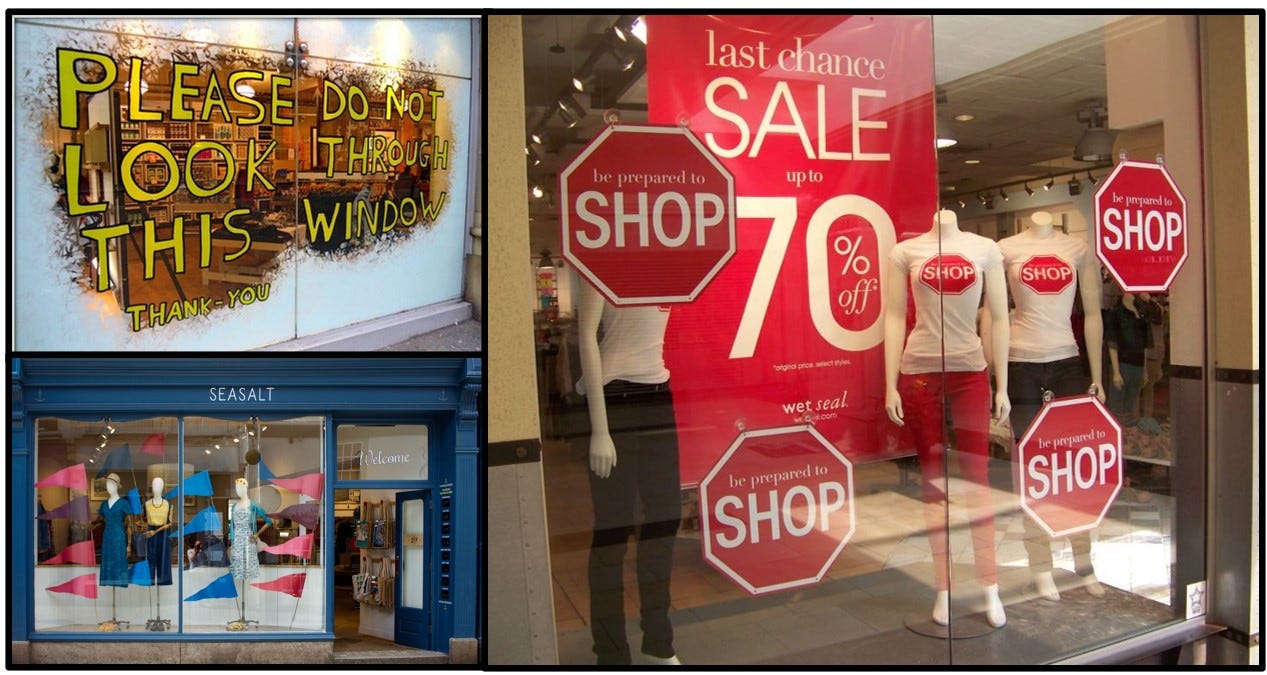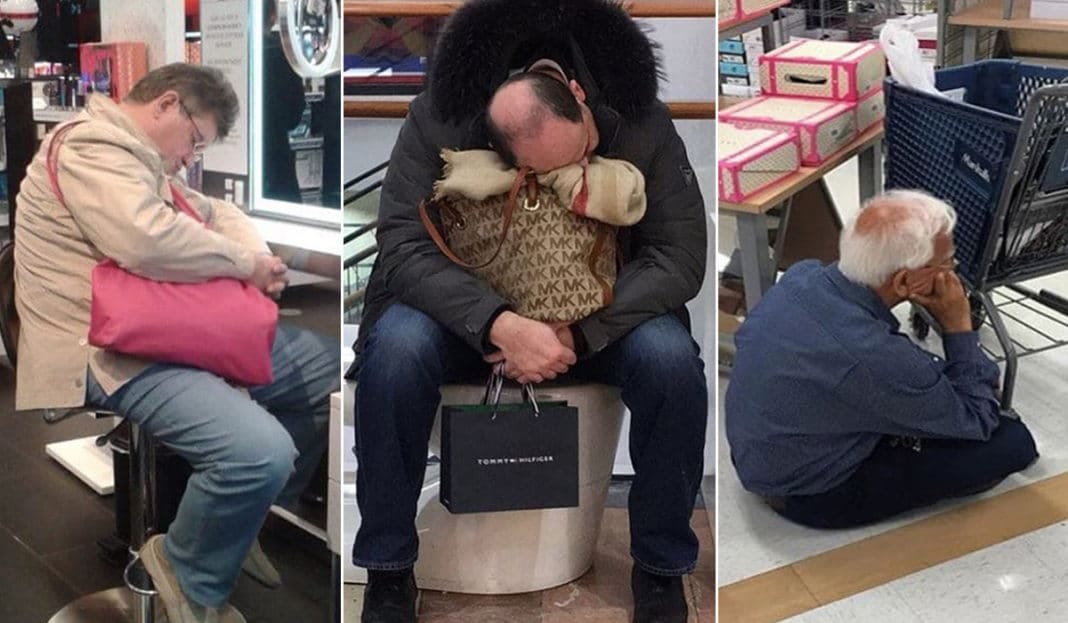Retailers: How to Increase Foot Traffic to Your Stores
...plus some "must read" guest experience statistics!
After two years of either vastly diminished or literally no in-store traffic, it feels great to see that consumers are returning to physical stores and shopping centers in droves. In many cases traffic (and sales) are running well above 2019 levels, which is certainly bullish. Is this a “rebound” effect kicking in or the early stages of a longer term trend? Nobody knows. But, what I do know is that as retailers, we can never have enough visitors to our stores, malls, and shopping centers. So, this issue contains a bunch of ideas (all proven with first-hand experience) to drive extra traffic.
Be sure to also check out the stats regarding the consumer experience, and how important it is to your business to provide a great one.
Of greatest importance, thoughts & prayers to all of the people of Ukraine.
If you are interested in a low cost means of marketing to 7,500 retail decision makers, you should consider advertising here. It’s an inexpensive way to get your offering seen in a very uncluttered and effective ad environment. Click the button to learn more:
Sponsored Content
Are You Challenged with Excess Inventory Tying Up Your Working Capital?
Plan B Distribution helps companies solve their inventory and debt problems. When Plan A doesn't work, then we are your Plan B solution. We have 30 years of experience helping companies with the following challenges:
- Inventory evaluations
- Asset management
- Liquidations, inventory sell-offs
- Logistics
- Warehousing
- 3PL/fulfillment services
- Debt management and more.
Our 500+ customers include banks, VCs, investors, manufacturers, wholesalers, distributors, and both physical and online retailers. We have helped them move over 500,000,000+ units of excess inventory, freeing up both cash and space. We do so under strict confidentiality and control exactly where your product is sold.
Learn more about how we can assist your business with asset disposition, inventory reductions, or logistical challenges. Call Ryan at Plan B, 818-848-6111 or visit www.aplanb.com.
There isn’t a bricks & mortar merchant anywhere that would turn away the opportunity to generate additional store traffic. After all, there are only two ways to increase sales: more transactions or a higher average order value (or ideally both).
To drill down a bit further, “more transactions” results from some combination of increasing store traffic and improving the rate in which you convert that traffic into sales (“conversion rate”). Today, I want to cover the former and share a bunch of ideas for increasing store traffic.
You may know some of these tactics, and possibly have used them as well. But how many are you currently leveraging, or at least planning to? Sales driving efforts, even those that work well, tend to be forgotten in the hunt for something new and different. So, if you have tried these before or not, each one is worth considering. They work.
Oh, by the way, many of these ideas, executed well, will improve your conversion rates as well as your store traffic. A nice, added bonus!
I am going to keep the explanations brief as none of these ideas are complicated, and I would rather fit in a few extra tactics instead. As always, if you want to dig deeper into any of them, hit me up (email me)!
Optimize Your Google “My Business” Listing (or create one):
46% of all searches on Google are focused on local subjects, and many of them include variations of "can I buy" or "to buy." Further, 88% of people who run a local search visit a related store within a week. Long story short, Google can drive traffic to physical stores.
Go to Google My Business and either set up a profile or optimize the one you previously created. Include as many details about your business as possible, including address, shopping center/mall name, phone number, hours of operation, special features, URL, description of your offering and plenty of pictures.
Leverage Free Search Engine Submissions:
Search Engines drive consumer awareness and actions. Google alone has about 5 Billion searches conducted on its platform daily. In this world of paid ads, organic search still counts for more than 50% of clicks generated. One of the easiest and cheapest ways to get your website found by searchers is submitting it to various submission sites, often for free. While some say the major platforms like Google and Bing do not require this, there is little downside in going through the process. Check this article out for more detail and a list of submission sites.
Chase Free Media Coverage & PR:
Craft a short email or phone pitch focusing on something that makes your business special (grand opening, anniversary, charity tie-in, giveaway, success through Covid, etc.) and reach out to journalists that cover retail and related industries and local business writers to ask for a feature story. HARO (short for Help a Reporter Out) is a great service that will help you connect with writers who are looking for sources for their articles.
Ask Your Happy Customers to Spread the Word:
You don’t need to be on Twitter or TikTok to go viral. Word of mouth can be very powerful in helping you increase store traffic. Simply ask your customers to chat up your brand to their friends and families. It will help if you suggest a specific topic to share, such as a pending sale event, a specific new item arrival, or simply the availability of a favorite product or product line. Always ask for referrals.
Have a Consistent Social Media Presence:
Post about your products, services, and customer reviews on a regular basis. Use both images and videos. Experiment with different features such Stories, Reels, and even Live (if you do well in real time speaking). Be sure to include a call to action, a link to your website or location(s), and appropriate hashtags. 75% of consumers buy products they discover on social media, so don’t ignore social media.
Test Micro-Influencers:
This one is a bit more challenging as it relies on choosing the right influencer at the right price. I suggest a micro-influencer (lower cost) who has a minimum of 3,000-5,000 followers and has a content focus that ties to your brand and product offering. Payment is often in cash but there is always an opportunity to compensate the influencer in product samples.
Once you choose an individual, show them around your store(s), offer them product samples, share logos, locations and URLs, provide guidance where it makes the most sense to shoot photos and images (that best represents your business) and be sure they shoot lots of them. Track their postings to determine the impact on your traffic and sales.
Use Mobile Marketing (SMS):
Some people are not fans of receiving marketing messages via text (myself included). But, SMS marketing is very uncluttered (there is not a lot of competition) and therefore it enjoys sky-high open and conversion rates as opposed to email programs and similar. So, if you collect your customers’ mobile numbers, and they have opted-in to mobile marketing, text them occasionally about new arrivals, your current promotion, or even send them a virtual coupon.
Think Local:
The concept of “buy local” has been meaningful for many years, and this certainly can apply even to multi-unit merchants. Every store is staffed by local team members and service by local companies, so any business can and should “Think Local”. Support neighborhood organizations (try providing space for the Girl Scouts to sell their cookies and see the power of word-of-mouth), sponsor community events, donate to local charities.
Stop Outside Traffic in Their Tracks with a Sandwich Board:
Buy an inexpensive sandwich board and put it outside of your store. Update it regularly with fun and compelling messages, such as a sale event, a new arrival, or just a witty saying. The goal is to grab the attention of shoppers passing by and hopefully bring them into your store.
Create Thrilling Window Displays:
Just as sidewalk signage stops passing traffic, so do compelling window displays. Devote the appropriate time to ensure both product presentations as well as brand and/or promotional messaging are eye-catching. Don’t just stand in front of the windows reviewing your design, but walk up on your store from the left side and the right side to view the windows as shoppers do when they approach your store.
Use Inflated Balloons:
Balloons attract attention and will help bring more shoppers into your store. Place helium filled balloons at your entrance, around your exterior storefront, and inside where they are visible from outside. They can be mylar balloons with designs or messaging on them, or basic latex balloons. Once caveat: keep them fully inflated (consider keeping a mini-helium tank on hand).
Offer “Meet the XXXX” In-Stores:
Invite author’s, fashion designers, local influencers, subject matter experts (ex: vets at a pet store) to your store to speak about their business and meet your customers. Promote each pending guest visit aggressively in-store (signs and bag stuffers), via email, on social media, and by word of mouth. Each event, well planned, will bring in incremental traffic to your store(s).
Conduct In-Store Classes:
Similar to the “meet the XXX” idea above, in-store classes are a great way to attract consumers and build stronger relationships with them in the process. Beauty classes, crafting classes, home improvement classes, dog training classes, you get the idea. Choose a topic that’s relevant to your offering and plan free learning sessions. Once again, they need to be promoted aggressively to maximize their value.
Conduct Trunk Shows:
Identify manufacturers of products that are complementary but not cannibalistic to your assortment, and bring them in to run limited duration trunk shows. Carve out a bit of space for them, allow them to set up their products and man the display, and promote the short term offering to bring in new shoppers. Your guests will appreciate the element of surprise in being able to find some new and different in your store. They are also more likely to visit knowing they only have a few days to see these new products (FOMO). Beyond the additional traffic, you may want to negotiate a deal with the trunk show operator where you get a percentage of their sales made on-site. Here is some more detail about trunk show best practices.
“Post-Event” Social Media:
For the three event-focused ideas above, be sure to takes tons of photos, videos, and collect customer comments to use in future marketing efforts (social media in particular). It’s a powerful way for you to communicate some of the things that makes your business special and stand apart from the competition.
You Want More???
Ok, if you insist! Here are five more bullet point ideas that you can use to help drive more traffic:
Cross promote your offerings with non-competitive stores with displays, signs, coupons, and more in their locations and do the same for them.
Use bounceback offers (coupons, emails) to incentive your existing guests to return more often.
Provide beverages and/ or snacks for your guests. People love, love, love free food (think Costco sampling programs).
Think companion convenience. Mom’s will be more likely to visit with their kids if you have a small play or reading area to keep them busy. Husbands are more likely to tag along with their wives if they have a place to sit and perhaps even wifi and phone charging outlets.
Be sure the environment outside of your store is safe and secure. Good lighting, security presence, etc. will all create a sense of confidence in visiting your store shopping center.
Sponsored Content
Product Sourcing Simplified!
Now available for prospective product buyers. Slots are limited!
A powerful U.S. - Asian product sourcing & design partnership to support sellers of all sizes. Leverage our 55 years of combined experience to grow your sales and reduce your product costs, all at no cost to you!
15 Stats That Demonstrate the Importance of Providing a Great Customer Experience
I have preached about the value of providing great guest service and a superb customer experience for longer than I can remember. In fact, the first issue of All Things Retail covered that very topic (as did many subsequent issues).
There are few, if any, merchants that will differ with my opinion. However, when the time comes to act on this theory, most retailers are sub-par. Too busy, other priorities, we can’t figure out how to do it, the excuses are plentiful. My view is with the proper focus, guest service/experience can be improved rather quickly. Done consistently, eventually that service/experience can be consider good, very good, or even great. But it begins with that focus.
Hopefully some of these fact-based stats will bring home the true value of a great experience and reboot the focus on this vital subject.
89% of consumers have switched to doing business with a competitor following a poor customer experience.
A 5% increase in customer retention can produce 25% more profit.
Keep reading with a 7-day free trial
Subscribe to All Things Retail to keep reading this post and get 7 days of free access to the full post archives.

